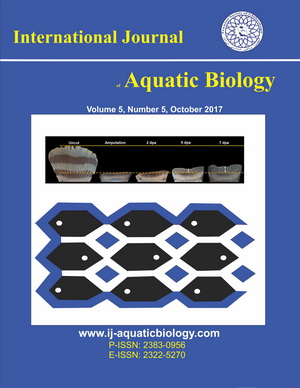Effects of intraperitoneal injection of safflower (Carthamus tinctorius) extract in Caspian roach (Rutilus caspicus) broodstocks in exposure to ammonia stress
Downloads
The objective of the present study was to investigate the effects of safflower extract on some serological parameters and the resistance to ammonia stress in the Caspian roach (Rutilus caspicus). For this purpose, 150 fish with an average weight of 61.73±0.32 g were allocated into 15 aquaria. The fish were divided into one control group and four treatment groups, with three replications for each group. Fish of the treatment groups were intraperitoneally injected with different levels of safflower extract, including 50 mg/kg (treatment 1), 100 mg/kg (treatment 2), 200 mg/kg (treatment 3), and 300 mg/kg (treatment 4), respectively. The fish in the control group just received normal saline via IP injection. After 2 weeks, blood samples were taken to evaluate some haematological and biochemical parameters. According to the results, serum glucose levels were significantly lower in all treatment groups compared to control 2 weeks post-injection. Total protein levels were measured higher in treatments 1 and 2 compared to control, but treatments 3 and 4 were recorded lower than control one. The levels of ALP and AST enzymes also decreased in fish that received safflower extract. The results of ammonia stress showed that injection of different levels of safflower extract led to an increase in the survival rate of Caspian roach in exposure to ammonia stress.
Downloads
Altundag M.S., Tiril S.U., Ozdemir A. (2014). Effects of safflower oil supplementation in diet on growth performance and body fatty acid composition of turbot (Psetta maxima). Aquaculture, 22(2): 597-605.
Asgary S., Rahimi P., Madani H., Mahzoni P., Kabiri N. (2012). Preventive effect of hydroalcoholic extract of Carthamus tinctorius petal in the appearance of type 1-diabetes mellitus in adult male rats. Iranian Journal of Biology, 26(1): 145-153. (in Persian)
Awad E., Awaad A. (2017). Role of medicinal plants on growth performance and immune status in fish. Fish and Shellfish Immunology, 67: 40-54.
Blaxhall P.C., Daisley K.W. (1973). Routine haematological methods for use with fish blood. Journal of Fish Biology, 5(6): 771-781.
Citarasu T. (2010). Herbal biomedicines: a new opportunity for aquaculture industry. Aquaculture International, 18(3): 403-414.
Dacie J.V., Lewis S.M. (2001). Practical Haematology. 9th, ed.Churchill Livingstone, London. 633 p.
Dadras H., Hayatbakhsh M.R., Shelton W.L., Golpour A. (2016). Effects of dietary administration of Rose hip and Safflower on growth performance, haematological, biochemical parameters and innate immune response of Beluga, Huso huso (Linnaeus, 1758). Fish and Shellfish Immunology, 59: 109-114.
Dernekba? S., Kerim M., Alagil F. (2015). Effect of dietary safflower and canola oil on growth performance, body, and fatty acid composition of rainbow trout (Oncorhynchus mykiss). Journal of Aquatic Food Product Technology, 24(2): 131-142.
Eagderi S., Mouludi-Saleh A., Esmaeli H.R., Sayyadzadeh G., Nasri M. (2022). Freshwater lamprey and fishes of Iran; a revised and updated annotated checklist-2022. Turkish Journal of Zoology, 46(6): 500-522.
Emerson K., Russo R.C., Lund R.E., Thurston R.V. (1975). Aqueous ammonia equilibrium calculations: effect of pH and temperature. Journal of the Fisheries Research Board of Canada, 32: 2379-2383.
Guan B., Hu W., Zhang T.L., Duan M., Li D.L., Wang Y.P., Zhu Z.Y. (2010). Acute and chronic un-ionized ammonia toxicity to ‘all-fish’ growth hormone transgenic common carp (Cyprinus carpio L.). Chinese Science Bulletin, 55: 4032-4036.
Harikrishnan R., Balasundaram C., Kim M.C., Kim J.S., Han Y.J., Heo M.S. (2009). Innate immune response and disease resistance in Carassius auratus by triherbal solvent extracts. Fish and Shellfish Immunology, 27(3): 508-515.
Hasanpour SH., Eagderi S., Mojazi-Amiri B., Moradi M. (2016). Skeletal development of the caudal complex in Caspian roach (Rutilus caspicus) (yakovlev, 1927) (Teleostei: Cyprinidae). Biharean Biologist, 10(1): 16-19.
Hasanpour SH., Eagderi S., Mojazi-Amiri B. (2015). Osteological development of the vertebral column, paired, dorsal and anal fins in Rutilus caspicus, Pravdin (1927) (Teleostei: Cyprinidae). Caspian Journal of Environmental Sciences, 13(3): 207-219.
Hoseini S.M., Hedayati A., Ghelichpour M. (2014). Plasma metabolites, ions and thyroid hormones levels, and hepatic enzymes? activity in Caspian roach (Rutilus rutilus caspicus) exposed to waterborne manganese. Ecotoxicology and Environmental Safety, 107: 84-89.
Hoseini S.M., Hedayati A., Mirghaed A.T., Ghelichpour M. (2016). Toxic effects of copper sulfate and copper nanoparticles on minerals, enzymes, thyroid hormones and protein fractions of plasma and histopathology in common carp (Cyprinus carpio). Experimental and Toxicologic Pathology, 68(9): 493-503.
Jun M.S., Ha Y.M., Kim H.S., Jang H.J., Kim Y.M., Lee Y.S., Kim H.J., Seo H.G., Lee J.H., Lee S.H., Chang K.S. (2011). Anti-inflammatory action of methanol extract of Carthamus tinctorius involves in heme oxygenase-1 induction. Journal of Ethno-Pharmacology, 133: 524-530.
Kiabi B., Abdoli A., Naderi M. (1999). Status of the fish fauna in the south Caspian Basin of Iran. Journal of Zoology in the Middle East, 18: 57-65.
Li L., Yang Y., Hou X., Gu D., Ba H., Abdulla R., Aisa H.A. (2013). Bioassay-guided separation and purification of water-soluble antioxidants from Carthamus tinctorius L. by combination of chromatographic techniques. Separation and Purification Technology, 104: 200-207.
Mazandarani M., Dehghani Ghomshhani M., Soudagar M., Hoseini S.M. (2019). Improvement of common carp (Cyprinus carpio) fingerlings resistance to salinity stress with dietary safflower (Carthamus tinctorius L) extract supplementation. Journal of Aquaculture Development, 13(2): 99-106. (in Persian)
Mazandarani M., Sudagar S., Kolangi Miandare H. (2016). Short-time exposure to lethal unionized ammonia concentrations (high levels) in Caspian roach, Rutilus caspicus. Journal of Aquaculture Development, 10(2): 119-126. (in Persian)
Person-Le Ruyet J., Chartois H., Quemener L. (1995). Comparative acute ammonia toxicity in marine fish and plasma ammonia response. Aquaculture, 136: 181-194.
Piri H., Haghpanah A., Hamitabari A., Ghorbani R., Mazandarani M., Shakiba M., Iri Y., Shafei A., Kor A., Ahmadi A., Jabbari Y., Yelghi S., Sepahdari A. (2013). Investigation on the feasibility of Cultivation of Fingerling of the Roach (Rutilus rutilus caspicus) until marketable size in the earthern pond with brakish and fresh waters. Iranian Fisheries Research organization, Inland Waters Aquatics Stocks Research Center. 51 p. (in Persian)
Ruffier P.J., Boyle W.C., Kleinschmidt J.K. (1981). Short-term acute bioassays to evaluate ammonia toxicity and effluent standards. Journal of Water Pollution Control Federation, 53, 367-377.
Statistical Yearbook of Iran Fisheries Organization, 2014-2019. 2019. Iranian Fisheries Organization, Iran. No (1). 64 p. (in Persian)
Stoskopf M.K. (1993). Fish Medicine. W.B. Saunders Co. Philadelphia. 882 p.
Wajsbrot N., Gasith A., Krom M.D., Popper D.M. (1991). Acute toxicity of ammonia to juvenile gilthead seabream, Sparus uuratu, under reduced oxygen levels. Aquaculture, 92: 277-288.
Zargari A., Mazandarani M., Hoseini S.M. (2019). Histopathology of rainbow trout (Oncorhynchus mykiss) exposed to safflower extract (Carthamus tinctorius). Journal of Veterinary Research, 74(4): 502-511. (in Persian)
Copyright (c) 2024 International Journal of Aquatic Biology

This work is licensed under a Creative Commons Attribution 4.0 International License.








